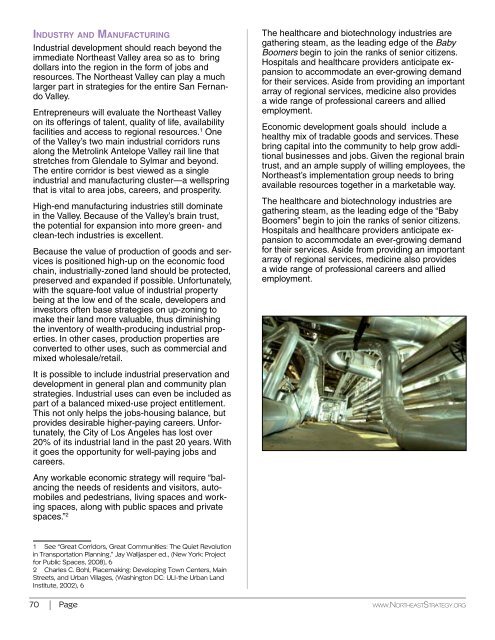Northeast San Fernando Valley
NEV%20Strategy%20Publication%20Draft%20Revision%20I
NEV%20Strategy%20Publication%20Draft%20Revision%20I
Create successful ePaper yourself
Turn your PDF publications into a flip-book with our unique Google optimized e-Paper software.
Industry and Manufacturing<br />
Industrial development should reach beyond the<br />
immediate <strong>Northeast</strong> <strong>Valley</strong> area so as to bring<br />
dollars into the region in the form of jobs and<br />
resources. The <strong>Northeast</strong> <strong>Valley</strong> can play a much<br />
larger part in strategies for the entire <strong>San</strong> <strong>Fernando</strong><br />
<strong>Valley</strong>.<br />
Entrepreneurs will evaluate the <strong>Northeast</strong> <strong>Valley</strong><br />
on its offerings of talent, quality of life, availability<br />
facilities and access to regional resources. 1 One<br />
of the <strong>Valley</strong>’s two main industrial corridors runs<br />
along the Metrolink Antelope <strong>Valley</strong> rail line that<br />
stretches from Glendale to Sylmar and beyond.<br />
The entire corridor is best viewed as a single<br />
industrial and manufacturing cluster—a wellspring<br />
that is vital to area jobs, careers, and prosperity.<br />
High-end manufacturing industries still dominate<br />
in the <strong>Valley</strong>. Because of the <strong>Valley</strong>’s brain trust,<br />
the potential for expansion into more green- and<br />
clean-tech industries is excellent.<br />
Because the value of production of goods and services<br />
is positioned high-up on the economic food<br />
chain, industrially-zoned land should be protected,<br />
preserved and expanded if possible. Unfortunately,<br />
with the square-foot value of industrial property<br />
being at the low end of the scale, developers and<br />
investors often base strategies on up-zoning to<br />
make their land more valuable, thus diminishing<br />
the inventory of wealth-producing industrial properties.<br />
In other cases, production properties are<br />
converted to other uses, such as commercial and<br />
mixed wholesale/retail.<br />
It is possible to include industrial preservation and<br />
development in general plan and community plan<br />
strategies. Industrial uses can even be included as<br />
part of a balanced mixed-use project entitlement.<br />
This not only helps the jobs-housing balance, but<br />
provides desirable higher-paying careers. Unfortunately,<br />
the City of Los Angeles has lost over<br />
20% of its industrial land in the past 20 years. With<br />
it goes the opportunity for well-paying jobs and<br />
careers.<br />
Any workable economic strategy will require “balancing<br />
the needs of residents and visitors, automobiles<br />
and pedestrians, living spaces and working<br />
spaces, along with public spaces and private<br />
spaces.” 2<br />
The healthcare and biotechnology industries are<br />
gathering steam, as the leading edge of the Baby<br />
Boomers begin to join the ranks of senior citizens.<br />
Hospitals and healthcare providers anticipate expansion<br />
to accommodate an ever-growing demand<br />
for their services. Aside from providing an important<br />
array of regional services, medicine also provides<br />
a wide range of professional careers and allied<br />
employment.<br />
Economic development goals should include a<br />
healthy mix of tradable goods and services. These<br />
bring capital into the community to help grow additional<br />
businesses and jobs. Given the regional brain<br />
trust, and an ample supply of willing employees, the<br />
<strong>Northeast</strong>’s implementation group needs to bring<br />
available resources together in a marketable way.<br />
The healthcare and biotechnology industries are<br />
gathering steam, as the leading edge of the “Baby<br />
Boomers” begin to join the ranks of senior citizens.<br />
Hospitals and healthcare providers anticipate expansion<br />
to accommodate an ever-growing demand<br />
for their services. Aside from providing an important<br />
array of regional services, medicine also provides<br />
a wide range of professional careers and allied<br />
employment.<br />
Equestrian Lifestyle for Fun and Profit<br />
The <strong>Northeast</strong> <strong>Valley</strong> is one of the few locales<br />
where authentic horse ranches and equestrian<br />
communities thrive. Mostly located in the foothills,<br />
these communities and this culture harkens back<br />
to the early agricultural days of the area, a time<br />
when virtually all of the <strong>Valley</strong> was rural—farms and<br />
ranches. Many of these were owned by movie stars<br />
and well-to-do Angelenos.<br />
According to Mary Benson who is an equestrian<br />
activist, there are approximately 3,000 horses in<br />
the 40 square miles zoned for horsekeeping in the<br />
<strong>Northeast</strong>. 1 Preserving these properties and fending<br />
off incompatible development is a constant<br />
challenge.<br />
With the <strong>Northeast</strong> communities overlapping the<br />
western edge of Angeles National Forest, there<br />
are virtually unlimited opportunities for horseback<br />
riding, hiking, eco-tourism, natural history hikes,<br />
photography, mountain biking, hang gliding, and<br />
nature study.<br />
The pleasure of horseback riding is undeniable.<br />
Horse ownership has always been as culturally<br />
horse riders experience, and the cultural experience<br />
owned by those who are recreational equestrians.<br />
2<br />
The equestrian economy, unique to the foothills, is an often overlooked<br />
asset—both recreationally and financially<br />
1 See “Great Corridors, Great Communities: The Quiet Revolution<br />
in Transportation Planning,” Jay Walljasper ed., (New York: Project<br />
for Public Spaces, 2008), 6<br />
2 Charles C. Bohl, Placemaking: Developing Town Centers, Main<br />
Streets, and Urban Villages, (Washington DC: ULI-the Urban Land<br />
Institute, 2002), 6<br />
1 Source: Mary Benson 8/17/2015; Horses and the Economy<br />
2 Mary Benson 8/17/2015 Email Horses and the Economy<br />
70 Page www.<strong>Northeast</strong>Strategy.org<br />
Draft Revision I - May 25, 2016<br />
Page 71


